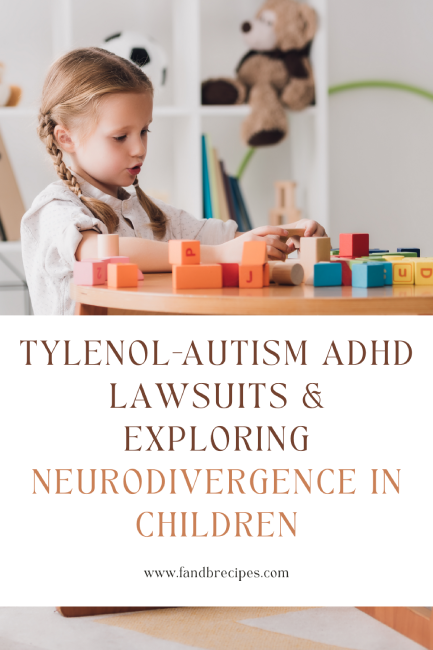Tylenol-Autism ADHD Lawsuits and Exploring Neurodivergence in Children
Neurodivergence is the layperson’s term for someone whose mind does not process the world in what is considered the typical fashion. This covers a wide range of mental health conditions, from depression and anxiety to bipolar disorder to learning disabilities and autism spectrum disorder. Neurodivergence isn’t necessarily a disease to be cured; it’s a variance in neurological function that changes a person’s experience.
This isn’t to say that neurodivergences don’t come without their fair share of challenges. Autism can lead to behavioural problems and overstimulation meltdowns, children with ADHD have trouble learning in a standard classroom, and mental wellness issues like depression and anxiety can affect a person’s physical health. But it is to say that there is much we don’t understand.
How Tylenol Is Being Linked to ADHD and Autism
In truth, we’re still learning what causes neurodivergence. It appears to be a mix of genetics and environmental factors. What some people with chronic health issues have come to learn is that sometimes you can have the gene that leads to a physical or mental divergence, but it doesn’t come up until an outside force “triggers” the condition. For instance, many new patients have been diagnosed with Postural Orthostatic Tachycardia Syndrome, an autonomic nervous system disorder, after being exposed to the recent COVID-19 outbreak. And now, researchers are finding evidence that children exposed to Tylenol while in utero or the first year of their life may be more likely to develop autism or ADHD.
The science isn’t conclusive, but it’s strong enough that many families are seeking compensation from manufacturers, retail distributors, or healthcare professionals for not providing adequate warning of the risks. And newly pregnant parents or parents with newborn children are being strongly advised to limit the usage of Tylenol and like products until more is understood.
Current findings indicate that children who had large amounts of acetaminophen present in their umbilical cord bloodstreams had a higher chance of testing positive for neurodivergence; children who took Tylenol or like products more than six times in their first year were three times more likely than their peers to have autism or ADHD.
Why Families Are Teaming up With Local Chicago Lawyers
The lawsuits against manufacturers and distributors aren’t particularly about anti-neurodivergent sentiments. Instead, it’s about providing the care and devices children need to thrive within a neurotypical society. Some children who grow up with neurodivergence are more impacted than others and may need caregivers for the rest of their life.
Therapies, medications, and care add up in expense. Many mental health therapies aren’t covered by health insurance in the United States despite their importance and cost. Parents are seeking compensation to help cover their child’s expenses and set them up for a comfortable life.
Did you know that fully trained service dogs cost tens of thousands of dollars? Mobility aids can range from hundreds to thousands as well. Quality sensory devices like noise-cancelling headphones, physical and occupational therapy, home renovations to better accommodate a neurodivergent child’s needs… All of these expenses add up. And it can be a battle to get insurance to help. Parents shouldn’t have to bankrupt their families to help their children.
Many experienced personal injury lawyers in Chicago are representing families in legal cases, from taking on the Tylenol-Autism/ADHD suits to taking on insurance companies who are complicating coverage. They can also help families connect with various medical experts and resources throughout Illinois.
Personal injury lawyers are dedicated to helping families seek justice and/or compensation when they are wronged by another party. This can include car accidents, workplace accidents, medical malpractice, and more. The acetaminophen lawsuits fall under product liability, where the people making and selling the medication should have known about certain risks and given adequate warning to pregnant parents.
Accepting and Addressing Neurodivergence in Children
Children diagnosed with neurodivergence often need extra help navigating a neurotypical world. Autistic children or those with ADHD may need IEPs at school, specialized programs that help accommodate their needs through schedule and work adjustments or tutoring. Perhaps your child needs sensory aids for being in public, like sunglasses or noise-cancelling headphones. The challenges and experiences of anyone on the autism spectrum are unique, so there is no one plan to help your child thrive. Learning to accept autism is learning to understand your child’s specific needs and find ways to accommodate them. The same goes for any neurodivergence.
Assistant devices, service dogs, emotional support animals, therapies, and medications are all options that can help neurodivergent children. You will need to work with their specialists and therapists to find what clicks, and it may take a few tries. There will be difficulties involved, of course, but modern families are lucky in the fact that there are far more resources available than there were even twenty years ago— including the testimony of autistic adults or people with other neurodivergence. For instance, ABA therapy was once touted as the best choice for anyone with neurodivergence; now, through the testimony of people under the hashtag “Actually Autistic,” we’ve seen this therapy come under new scrutiny and evolve to work with children instead of traumatizing them by trying to force them into the neurotypical mould.
Parents are always a child’s best advocate. You’ve been with your child since they were growing from cells or since their birth. You’re the first to understand their special quirks and recognize what shapes their moods. And until your child finds a form of communication that works for them, you are their voice.
Connecting to Communities
One of the best resources available to families dealing with neurodivergence is the community. Parents can find groups of other parents of neurodivergent children. They can also find adults with their child’s diagnoses who are willing to answer questions and give advice. However, it’s also important to be aware of the rampant ableism on the internet.
Many people fall into the trap of infantilizing people with neurodivergence like Autism or treating neurological variants like diseases. It’s alright and even healthy to recognize the challenges that come with these diagnoses and seek support; it is not ok to treat these children and adults like they are lesser or shouldn’t exist.
When researching support groups or organizations, look for any red flags like discussing cures or using outdated terms like “high and low functioning” or “Asperger’s Syndrome.” Discussing how well a child or adult “functions” with their autism is more complicated than once believed, as we now understand that autism is more of a spectrum than an A-to-B disorder. Asperger’s is outdated terminology that was once used to describe autistic people who were considered high-functioning, and the term was derived from the name of a Nazi who used unethical practices to research autistic patients.
When exploring the Autistic community specifically, you may come across the term ‘autism parents’ in a negative light. Please be aware that this isn’t a commentary on all parents whose children have autism; it is criticism of parents who victimize themselves and try to drown out autistic voices based on their experiences with their children.
Understanding Neurodivergence
Neurodivergence affects everyone differently. Many people describe it as a spectrum, referring to the full visual charts that include every hue and colour known to humankind before expanding into the invisible spectrum of light. Another way to think of it is a soundboard. Each slider represents a different aspect of life, from communication to each of the five senses. This can be applied to autism and ADHD, depression, anxiety, and more.
Learning Alternative Focus
Children with ADHD often have to find coping mechanisms for focus. This can include fidget devices, doodling during classes, pedal desks, or the ability to stand and pace when thinking. Many neurotypicals have difficulty understanding how these help someone focus, and that’s ok! The important thing is to know that they do, even if you don’t understand how or why. You can work with your child to find what works best for them and, if they attend school outside of the home, work with their teachers to find a way to incorporate these coping mechanisms into the classroom.
Other children with ADHD can benefit from extracurricular like sports or learning an instrument. These types of activities teach new ways to focus, help children learn to function with a team and give an outlet for extra energy.
Sensory Overstimulation and Self-Stimulating Behavior
You and your child will need to act as a team to discover what is overwhelming for them and how they can safely stim. “Stim” refers to habitual, repetitive behaviours that help your child self-stimulate. It can be an unusual noise or body movement, like hand flapping or finger flipping. As long as the action isn’t harmful, it’s important to let your child stim. Self-stimulation can affect various aspects of the body, including orientation and balance. It’s a way for people to regulate their senses and different aspects of their bodies; stimming has even been observed in some neurotypical individuals! Have you ever found yourself tapping your foot when anxious or twirling your hair because you’re bored? Perhaps you tap your fingers when thinking or click a pen. These all count as stimming behaviours.
If your child’s stimming behaviour is harmful, however, such as banging their head on solid surfaces, you can work with their specialists to help them find a different way to cope through various therapies.
Understanding the Difference Between Service Dogs and Emotional Support Animals
Many people benefit from the presence of animals in the family, some more so than others. Animals can help children learn and appreciate companionship as they attempt to navigate a less-than-accessible community. Animals are also shown to help humans better regulate their emotions.
In some instances, a therapist or psychologist may prescribe this company by suggesting what is referred to as an Emotional Support Animal. In others, your child may need a companion who can perform specific tasks for them, known as a service animal. Both companions are essential to your child’s well-being, but they are afforded different rights above and beyond standard pets.
According to the ADA, a service animal is a dog or miniature horse that is specially trained to perform one or more tasks for a disabled person. You may have seen an animal “alert,” meaning they are trained to sense medical changes in their owner’s body and let them know if their blood sugars drop or a seizure is oncoming. Some dogs are trained to fetch items, open fridges and cabinets, and use assistive devices to help their owner with everyday tasks like laundry. All of these animals are known as “working” animals and are protected under the ADA for full societal access or reasonable accommodation, including being allowed in grocery stores and restaurants.
Currently, the same is not true for Emotional Support Animals. While not limited to dogs and miniature horses, they are limited in their additional protections. Emotional support animals can be allowed in pet-free residential facilities like an apartment with proper documentation from a medical provider…and that’s it. They cannot accompany their owners into stores, they do not have extra rights when travelling, and they are not covered under the ADA. Some advocacy groups want to see protections expand, but for now, their efforts have borne little fruit.
It’s important to understand the difference between these animals and to know your rights regarding them. People who attempt to claim ESAs are service animals do themselves and other disabled persons a disservice, especially if they disrupt service and lead to changes in policy that limit accommodations. Service dogs are thoroughly trained in specific behaviours for public spaces that companion animals and ESAs are not; it’s obvious if you know what to look for. Bringing an animal that hasn’t been trained as a service animal into a public space can detrimentally affect other patrons and lead to increased feelings of ableism in society.
By understanding the difference between ESAs and service dogs, you can protect your child’s rights and recognize areas where their companion animals won’t be able to help them cope, such as school or shopping trips. You can discover whether and when stores you frequent have sensory-friendly hours or find devices to help your child adapt to their surroundings.
Moving Forward
Learning to live with neurodivergence and disabilities is a process filled with trial and error. There will be meltdowns and tantrums, grades may fall and rise, and disruptive behaviours may get on your last nerve. You may experience long waiting lists for specialists and therapies and the exorbitant costs of medical care and devices. But in the end, you’ll realize it’s worth it to learn and discover how your child thinks and feels. You’ll find new ways to appreciate the world around you, new ways to approach various situations, and new ways to advocate for the needs of people with neurodivergence and disabilities. It’s love, it’s tears, it’s unadulterated joy, it’s maddening circles, it’s appreciating sights and colours in new ways…It’s magic. May your journey be filled with love and magic, enough to brighten up even the worst of days.




